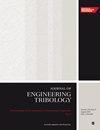Experimental investigation of thermo-physical and tribological properties of oil-based graphene oxide nano-fluid using two types of polysorbate (tween 20 and tween 80)
IF 1.8
3区 工程技术
Q3 ENGINEERING, MECHANICAL
Proceedings of the Institution of Mechanical Engineers, Part J: Journal of Engineering Tribology
Pub Date : 2023-07-12
DOI:10.1177/13506501231187017
引用次数: 0
Abstract
In this paper, the effect of adding Reduced Graphene Oxide (RGO) nano-particles to engine base oil (Poly-Alpha-Olefin-PAO) on the thermo-physical properties of nano-fluid such as viscosity, thermal conductivity, and friction coefficient, are investigated numerically and experimentally. To keep the nano-fluid stable, before using ultrasonic waves, two types of polysorbate (tween 20 and tween 80) as surfactants were added to four concentrations of 0.01, 0.02, 0.0375, and 0.05 wt%, and the effects of nano-particles were studied to find the best combination in terms of viscosity, thermal conductivity, and friction coefficient, which made the nan-fluid quite stable during the tests procedure. The results showed with good accuracy that the final nano-fluid was Newtonian and its viscosity was very similar to the base oil. An increase of 7% was observed between 25 °C and 75 °C and for the concentration of 0.02 wt%. Thermal conductivity was raised in all states with an increase in concentration and the highest effect was 8% in the concentration of 0.05 wt%. The friction tests proved a desirable decrease of as much as 45% in friction coefficient compared to base oil and 28% compared to common anti-friction material used in industry for the optimum concentration which was 0.02 wt%. In addition, experimental data were compared to the models presented in the literature and the models that could describe the behavior of this nano-fluid in the best way were reported, and an empirical equation (for each surfactant) is developed to show the variation of COF with nano-particles weight fraction in the nano-fluid.两种聚山梨酯(t20和t80)制备的油基氧化石墨烯纳米流体的热物理和摩擦学性能实验研究
本文通过数值和实验研究了在发动机基础油(聚α -烯烃- pao)中加入还原氧化石墨烯(RGO)纳米颗粒对纳米流体粘度、导热系数和摩擦系数等热物理性能的影响。为了保持纳米流体的稳定性,在使用超声波之前,将两种类型的聚山梨酯(tween 20和tween 80)作为表面活性剂加入到0.01、0.02、0.0375和0.05 wt%的浓度中,研究纳米颗粒对纳米流体的影响,从粘度、导热系数和摩擦系数方面寻找最佳组合,使纳米流体在测试过程中相当稳定。结果表明,最终得到的纳米流体为牛顿流体,其粘度与基础油非常接近。在25°C和75°C之间,浓度为0.02 wt%时,观察到增加了7%。随着浓度的增加,所有状态下的导热系数都有所提高,当浓度为0.05 wt%时,导热系数最高为8%。摩擦试验证明,与基础油相比,摩擦系数可降低45%,与工业上使用的普通抗摩擦材料相比,摩擦系数可降低28%,最佳浓度为0.02 wt%。此外,将实验数据与文献中提出的模型进行了比较,并报告了最能描述该纳米流体行为的模型,并建立了一个经验方程(针对每种表面活性剂)来显示纳米流体中纳米颗粒重量分数随COF的变化。
本文章由计算机程序翻译,如有差异,请以英文原文为准。
求助全文
约1分钟内获得全文
求助全文
来源期刊

CiteScore
4.20
自引率
5.00%
发文量
110
审稿时长
6.1 months
期刊介绍:
The Journal of Engineering Tribology publishes high-quality, peer-reviewed papers from academia and industry worldwide on the engineering science associated with tribology and its applications.
"I am proud to say that I have been part of the tribology research community for almost 20 years. That community has always seemed to me to be highly active, progressive, and closely knit. The conferences are well attended and are characterised by a warmth and friendliness that transcends national boundaries. I see Part J as being an important part of that community, giving us an outlet to publish and promote our scholarly activities. I very much look forward to my term of office as editor of your Journal. I hope you will continue to submit papers, help out with reviewing, and most importantly to read and talk about the work you will find there." Professor Rob Dwyer-Joyce, Sheffield University, UK
This journal is a member of the Committee on Publication Ethics (COPE).
 求助内容:
求助内容: 应助结果提醒方式:
应助结果提醒方式:


